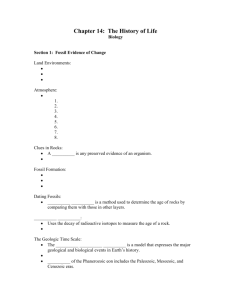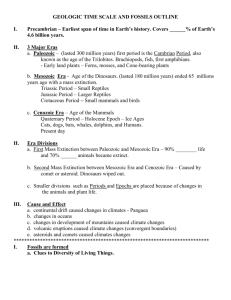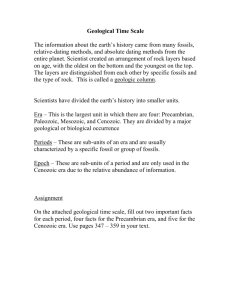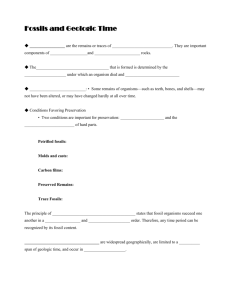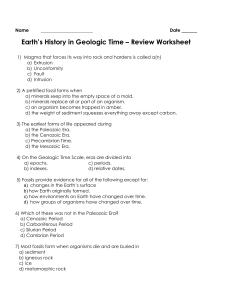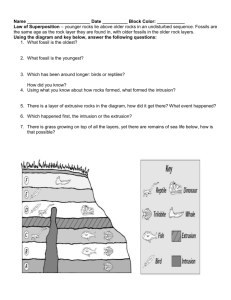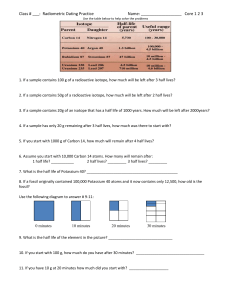Earth Science SOL Review Sheet #1
advertisement
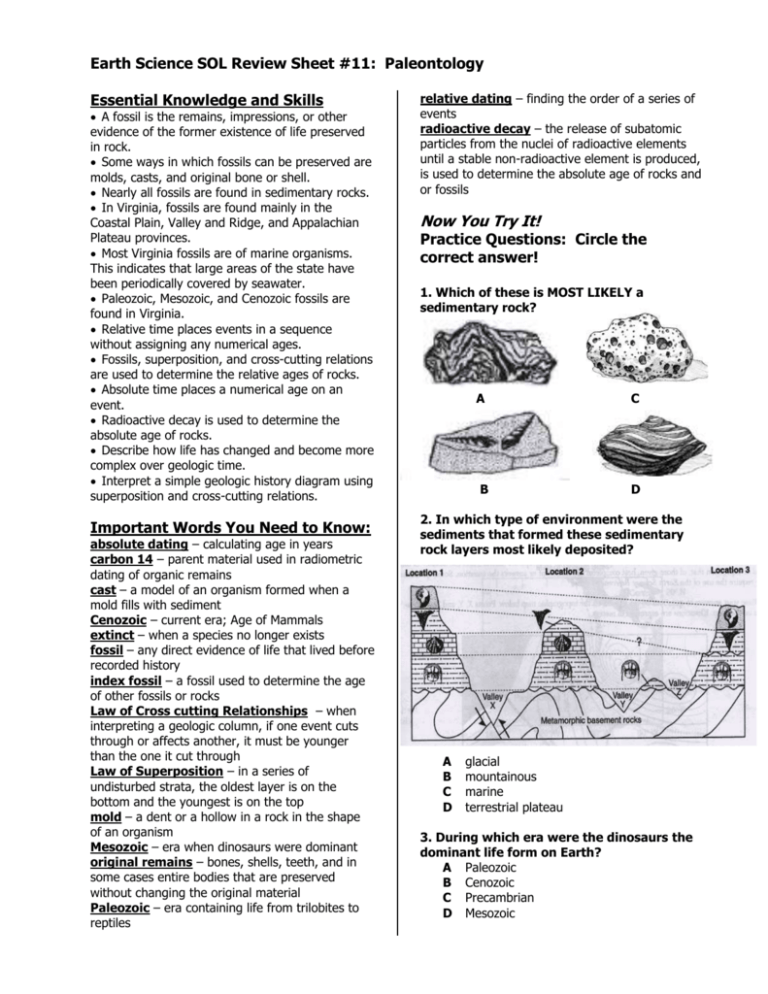
Earth Science SOL Review Sheet #11: Paleontology Essential Knowledge and Skills A fossil is the remains, impressions, or other evidence of the former existence of life preserved in rock. Some ways in which fossils can be preserved are molds, casts, and original bone or shell. Nearly all fossils are found in sedimentary rocks. In Virginia, fossils are found mainly in the Coastal Plain, Valley and Ridge, and Appalachian Plateau provinces. Most Virginia fossils are of marine organisms. This indicates that large areas of the state have been periodically covered by seawater. Paleozoic, Mesozoic, and Cenozoic fossils are found in Virginia. Relative time places events in a sequence without assigning any numerical ages. Fossils, superposition, and cross-cutting relations are used to determine the relative ages of rocks. Absolute time places a numerical age on an event. Radioactive decay is used to determine the absolute age of rocks. Describe how life has changed and become more complex over geologic time. Interpret a simple geologic history diagram using superposition and cross-cutting relations. Important Words You Need to Know: absolute dating – calculating age in years carbon 14 – parent material used in radiometric dating of organic remains cast – a model of an organism formed when a mold fills with sediment Cenozoic – current era; Age of Mammals extinct – when a species no longer exists fossil – any direct evidence of life that lived before recorded history index fossil – a fossil used to determine the age of other fossils or rocks Law of Cross cutting Relationships – when interpreting a geologic column, if one event cuts through or affects another, it must be younger than the one it cut through Law of Superposition – in a series of undisturbed strata, the oldest layer is on the bottom and the youngest is on the top mold – a dent or a hollow in a rock in the shape of an organism Mesozoic – era when dinosaurs were dominant original remains – bones, shells, teeth, and in some cases entire bodies that are preserved without changing the original material Paleozoic – era containing life from trilobites to reptiles relative dating – finding the order of a series of events radioactive decay – the release of subatomic particles from the nuclei of radioactive elements until a stable non-radioactive element is produced, is used to determine the absolute age of rocks and or fossils Now You Try It! Practice Questions: Circle the correct answer! 1. Which of these is MOST LIKELY a sedimentary rock? A B C D 2. In which type of environment were the sediments that formed these sedimentary rock layers most likely deposited? A B C D glacial mountainous marine terrestrial plateau 3. During which era were the dinosaurs the dominant life form on Earth? A Paleozoic B Cenozoic C Precambrian D Mesozoic Use this diagram to answer the next two questions. 4. Which statement gives an accurate age relationship for the bedrock in the cross section? A Intrusion A is younger than intrusion C. B Intrusion C is younger than intrusion B. C Intrusion B is older than intrusion A. D Intrusion C is older than layer E. 5. The most obvious (easily seen) buried erosional surface is found between rock units– A A and B B D and F C C and D D E and H 7. Which rock type is the oldest? A C B D 8. The diagram below represents the current number of decayed and undecayed atoms in a sample that was originally 100% radioactive material. 6. What does the presence of this fossil suggest about the area during the Devonian? If the half-life of the radioactive material is 1,000 years, what is the age of the sample? A 1,000 yr B 2,000 yr C 3,000 yr D 4,000 yr 9. During which era did man first appear? A Paleozoic B Cenozoic C Precambrian D Mesozoic A B C D swamp desert marine polar 10. What is the estimated age of the Earth? A 4.5 billion years B 4.6 billion years C 4.5 million years D 4.6 million years
